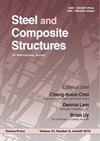Fatigue property analysis of U rib-to-crossbeam connections under heavy traffic vehicle load considering in-plane shear stress
IF 3.9
3区 工程技术
Q1 CONSTRUCTION & BUILDING TECHNOLOGY
引用次数: 7
Abstract
In this study, the fatigue property of U rib-to-crossbeam connections in orthotropic steel bridge (OSB) crossbeams under heavy traffic vehicle load was investigated considering the effects of in-plane shear stress. The applicability of an improved structural stress (ISS) method was validated for the fatigue behavior analysis of nonwelded arc-shaped cutout regions in multiaxial stress states. Various types of fatigue testing specimens were compared for investigating the equivalent structural stress, fatigue crack initiation positions, and failure modes with the unified standards. Furthermore, the implications of OSB crossbeams and specified loading cases are discussed with respect to the improved method. The ISS method is proven to be applicable for analyzing the fatigue property of nonwelded arc-shaped cutout regions in OSB crossbeams. The used method is essential for gaining a reliable prediction of the most likely failure modes under a specific heavy traffic vehicle load. The evaluated results using the used method are proven to be accurate with a slighter standard deviation. We obtained the trend of equivalent structural stress in arc-shaped cutout regions and validated the crack initiation positions and propagation directions by comparing them with the fatigue testing results. The implications of crossbeam spans on fatigue property are less significant than the effects of crossbeams.考虑面内剪应力的重型车辆荷载下U型肋-横梁连接疲劳性能分析
考虑面内剪应力的影响,研究了正交各向异性钢桥(OSB)横梁U型肋连接在重型车辆荷载作用下的疲劳性能。验证了改进的结构应力法在多轴应力状态下非焊接弧形切口疲劳行为分析中的适用性。采用统一的标准,对不同类型的疲劳试样进行对比,研究等效结构应力、疲劳裂纹起裂位置和破坏模式。此外,还讨论了OSB横梁和指定荷载情况对改进方法的影响。结果表明,ISS方法可用于分析OSB梁非焊接弧形切口区的疲劳特性。所使用的方法对于在特定的重型交通车辆荷载下获得最可能的失效模式的可靠预测是必不可少的。用所采用的方法评价的结果是准确的,标准偏差较小。得到了弧形切口区域的等效结构应力变化趋势,并与疲劳试验结果进行了对比,验证了裂纹的起裂位置和扩展方向。梁跨对疲劳性能的影响不如梁的影响显著。
本文章由计算机程序翻译,如有差异,请以英文原文为准。
求助全文
约1分钟内获得全文
求助全文
来源期刊

Steel and Composite Structures
工程技术-材料科学:复合
CiteScore
8.50
自引率
19.60%
发文量
0
审稿时长
7.5 months
期刊介绍:
Steel & Composite Structures, An International Journal, provides and excellent publication channel which reports the up-to-date research developments in the steel structures and steel-concrete composite structures, and FRP plated structures from the international steel community. The research results reported in this journal address all the aspects of theoretical and experimental research, including Buckling/Stability, Fatigue/Fracture, Fire Performance, Connections, Frames/Bridges, Plates/Shells, Composite Structural Components, Hybrid Structures, Fabrication/Maintenance, Design Codes, Dynamics/Vibrations, Nonferrous Metal Structures, Non-metalic plates, Analytical Methods.
The Journal specially wishes to bridge the gap between the theoretical developments and practical applications for the benefits of both academic researchers and practicing engineers. In this light, contributions from the practicing engineers are especially welcome.
 求助内容:
求助内容: 应助结果提醒方式:
应助结果提醒方式:


